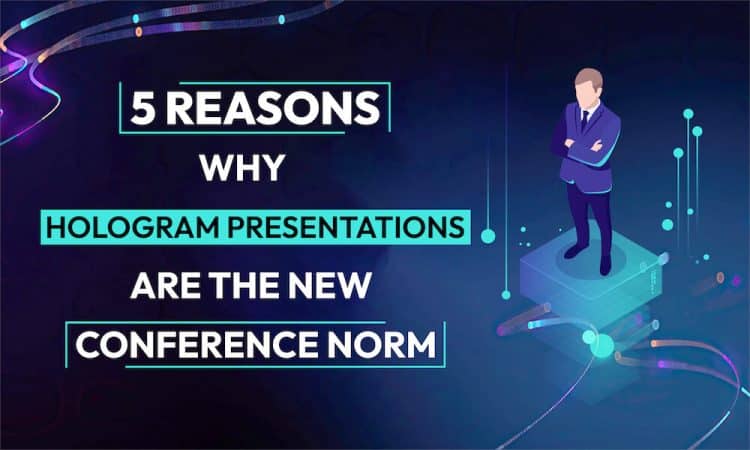
Imagine attending a conference unlike any you’ve ever experienced before. As you enter the hall, you find yourself surrounded by an ethereal ambience, a perfect fusion of technology and imagination. You find that holographic displays grace the room instead of traditional stages and podiums. The air hums with anticipation, and as the light dims, a three-dimensional holographic presenter materializes before your eyes, ready to deliver a groundbreaking presentation.
Welcome to the era of hologram presentations, where the boundaries of traditional conferences are shattered, and a new norm emerges!
This article will explore how hologram presentations have revolutionized the conference landscape, captivating audiences, transcending geographical barriers, and redefining how we connect and communicate in the digital age. Pull up your socks to embark on a journey where we will discuss some of the benefits of using holograms, along with examples of how some of the top organizations have harnessed the power of this technology and notched up their presentations.
What is Holographic Communication?
Before we delve into the uses of holographic presentations, let us first understand the meaning of holograms and the technology behind them.
Holograms are images created using laser technology that can be projected onto a stage or in a dedicated room and offers innumerable benefits over traditional conferencing methods.
The development of holography has led to a revolutionary advancement in photography and film that opens a new world of possibilities for presentation. 3D holograms provide a unique viewing experience, displaying objects and animated sequences in a form that appears to float freely in space. Unlike conventional films on standard screens, holograms are visible from all angles.
One of the most exciting features of holograms is that they do not require any gear, such as glasses or headsets, to view them. This provides a significant advantage in presenting at trade fairs, exhibitions, and similar events, as everyone can see them without the need for additional equipment.
Importance of Hologram Presentations
1. Enhance Engagement and Interaction
Holograms are cutting-edge technology that has revolutionized the way we communicate with each other. They offer a unique and dynamic platform for presentations and conferences. They create a sense of oneness and allow attendees to feel as if they are being included in the presentation rather than just being passive observers.
Let us understand with the help of an example. In 2017, the late physicist Stephen Hawking delivered a speech at the University of Oxford in Hong Kong by appearing as a hologram, showcasing the evolution of technology and sciences.
This provided the students with a visual and interactive experience that was much more engaging and memorable than a regular presentation. Attendees were able to even interact with the holographic presentation.
Watch here – https://www.youtube.com/watch?v=suS_flYdKEc
2. Reach Wider Audiences
Hologram is a powerful tool for extending the reach of conferences beyond the confines of a single physical location. With the ability to project images and presentations in multiple locations simultaneously, holograms provide a cost-effective and efficient way to expand the audience of a conference.
For example, attendees at multiple global locations can participate in a hologram-enabled conference, providing them access to valuable content and networking opportunities. Similarly, companies that might not be able to travel to multiple locations can leverage hologram technology to deliver the same content worldwide.
Watch how companies have been using holograms to create their presence globally.
3. Save Time and Resources
Even though conferences provide a plethora of opportunities for growth and development, they can often require significant investments of time, money, and resources. They turn out to be expensive as logistics and accommodation costs increase.
However, hologram technology can reduce travel and eliminate the need to host a physical event, saving much of your time and resources. By creating virtual representations of speakers or attendees, holograms can enable remote participation in conferences and other events.
This trend has gained massive traction in recent years, especially after the COVID-19 pandemic, and is being used by experts from all sectors.
For example, medical professionals increasingly use holograms to participate in conferences and training sessions remotely. They can participate in discussions, practice physical training with holographic visuals, and attend major events from the comfort of their home.
4. Display Abstract Art
Holograms present an exciting opportunity to display abstract art in a unique and captivating manner. They offer a three-dimensional representation of artwork and masterpieces which people at different locations can view without even having the physical art present there.
Let us understand in detail the example of the Van Gogh art shows being held in India, which perfectly demonstrate the potential of holography in showcasing abstract art.
In recent years, immersive exhibitions featuring the works of Vincent van Gogh have gained immense popularity worldwide. These exhibitions utilize holographic technology to create a multisensory experience that brings Van Gogh’s abstract and vibrant paintings to life.
One such exhibition, “Van Gogh: A Holographic Journey,” made its way to India, captivating art enthusiasts and fans of the renowned Dutch artist.
As visitors enter the exhibition arena, they are immediately immersed in a world of Van Gogh’s artistic genius. Instead of simply observing static paintings on a wall, they are surrounded by large-scale holographic projections of Van Gogh’s iconic artworks. The holograms showcase the vibrant brushstrokes, rich colors, and intricate details of his abstract masterpieces.
The holograms enable viewers to experience the depth and texture of his paintings, bringing the layers of colors and dynamic brushwork to life. As viewers move around the exhibition, the holographic displays change perspective, revealing new angles and hidden details, enhancing their understanding and appreciation of Van Gogh’s artistic vision.
By leveraging holographic technology, these exhibitions bridge the gap between the audience and the artworks, creating a dynamic environment that captivates and educates viewers.
5. Showcase Products and Services
Using holograms to showcase products has become increasingly popular for businesses across various industries. It enables companies to present their products in a detailed manner and leave a positive impact on potential customers.
For instance, a medical equipment company could use holograms to demonstrate how their products work. This technology would allow the audience to see how the equipment functions and how it can benefit patients in real time.
Holograms are even being programmed to show different angles, close-ups, and simulations of products, providing the audience with a comprehensive understanding of their features and benefits. This has mainly been helpful for places where products cannot be brought along physically, such as trade shows and conferences.
Let us understand with the example of how the famous car company, BMW, used this technology to launch its new 7 Series in Moscow. BMW displayed a hologram of its latest model on a transparent screen that appeared to float in mid-air, creating the illusion that the car was there. The holographic visual also allowed the audience to view the vehicle from multiple perspectives, giving them a detailed view of the interiors.
Things to Keep in Mind While Curating and Delivering Hologram Presentations
While using holograms for conferences, there are several important factors to remember. Here are a few of them-
1. Technology and Infrastructure
Ensure the venue has the technological infrastructure to support holographic displays, including projectors, screens, and quality audio systems. Thus, you must collaborate with experienced technicians and holographic experts to set up and optimize the projection system.
2. Content and Visuals
Craft compelling and visually engaging content tailored explicitly for holographic presentations. Consider the three-dimensional nature of holograms and design visuals that leverage depth, movement, and interactivity. You can also use vibrant colors, dynamic animations, and detailed graphics to maximize the impact of the display.
3. Rehearsals and Preparation
It is highly crucial to conduct thorough rehearsals with the presenters and holographic performers to ensure smooth and synchronized interactions. You must also familiarize them with the holographic technology, gestures, and cues: practice timing, transitions, and any specific movements required for a flawless experience.
4. Lighting and Stage Setup
Pay close attention to the lighting conditions at the venue, as excessive ambient light or reflections may interfere with the holographic projections. You can coordinate with lighting specialists beforehand and create an optimal environment that enhances the visibility and clarity of your holograms.
5. Audience Engagement
Consider how you can use holograms to enhance audience engagement and boost interaction. One of the easiest ways to do so is by integrating live question-and-answer sessions or interactive elements that allow participants to engage with the holographic content. This can be done through live polling, augmented reality overlays, or interactive touchscreens that complement the holographic experience.
6. Bandwidth and Network Stability
Nobody wants to witness a holographic presentation that lags or gets interrupted. Thus, ensure a robust internet connection with sufficient bandwidth to support the holographic transmission without any glitches. Perform network testing before the conference to identify and resolve potential issues that may arise.
7. Backup Plans
Have contingency plans in place to mitigate technical difficulties or unexpected challenges during the conference. This may include backup holographic systems, alternative presentation formats, or backup presenters who can seamlessly take over if needed.
8. Accessibility and Inclusivity
To make your audience feel welcomed and included, consider the accessibility needs of all participants, including those with visual or hearing impairments. Provide alternative ways to access the content, such as captioning or audio descriptions, to ensure an inclusive experience for all attendees.
The Future of Hologram Presentations
With technological advances, holograms are becoming more accessible and affordable, and our imagination only limits their potential uses. They can potentially transform how companies communicate with their customers and investors.
Hologram technology will likely continue to evolve and improve, with new advancements and features enhancing its usefulness. It is clear that the future of hologram presentations is bright, and we can expect to see them becoming an increasingly common part of our lives in the years to come.
Conclusion
As we bid adieu to traditional conferences, we must focus on mastering the art of delivering hologram presentations, as the future of conferences lies in this realm. It has opened doors to a world where science fiction becomes a stunning reality and can mesmerize viewers in the blink of an eye. Thus, brace yourself for a new era of conferences where holograms reign supreme, propelling us into a future where innovation, connection, and inspiration know no bounds.



